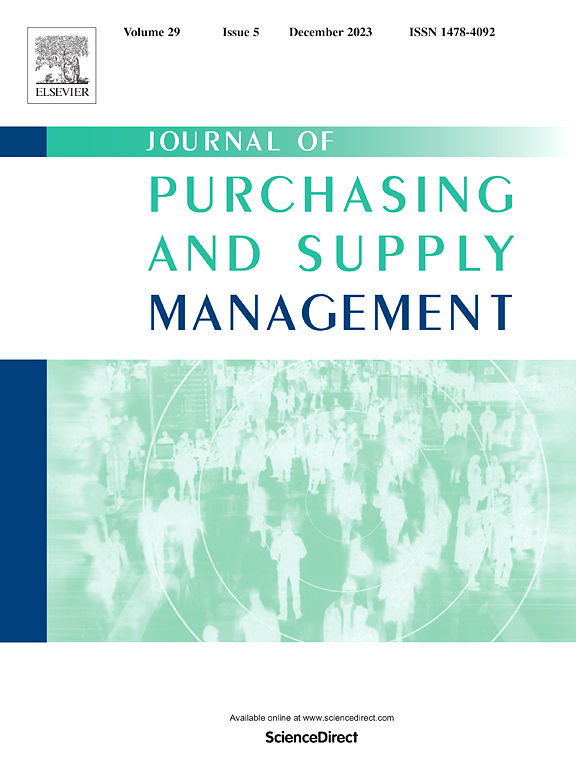Towards a theory of supplier embeddedness: Contextualized mechanisms, contingent conditions, interactive properties and unorthodox observations
IF 8.7
2区 管理学
Q1 MANAGEMENT
引用次数: 0
Abstract
Buyer-supplier relationships, as typical hierarchical inter-firm arrangements, epitomize embedded dyadic situations, particularly for the suppliers' part. The embeddedness processes, presumably, will be different for suppliers and buyers. Extant embeddedness theory, however, does not differentiate the processes between the two parties. Rather, the prevalent approach to firm-level embeddedness simply borrows or elevates individual-level theorization. Consequently, the literature falls short in explaining how suppliers, as subordinate parties, are embedded in generally status-asymmetric relations. To fill the theoretical gap, this study theorizes supplier embeddedness (SE)—i.e., how a supplier's ways of strategizing, deciding and behaving are constrained by its (significant) buyer, and the extent to which such pattern varies across suppliers. Given the exploratory nature and theory elaboration purpose of our inquiry, we use a case-based research method. Specifically, we conducted case studies of eight suppliers of a single automaker (Automo) and employed abductive (merging inductive and deductive) reasoning, as particularly suited for theory elaboration. Our analysis of qualitative data revealed noticeable variances in suppliers' SE with respect to Automo, while unearthing context-specific mechanisms and their interactive properties that jointly characterize SE, as well as its antecedent/contingent conditions that define the boundaries of SE. Additionally, we made some unorthodox observations on inter-firm reciprocity and brokerage in our context. These findings are summarized in the form of propositions for future research.
供应商嵌入理论:情境化机制、偶然条件、交互特性和非正统观察
买方-供应商关系,作为典型的等级企业间安排,是嵌入式二元情况的缩影,特别是对供应商而言。对于供应商和买家来说,嵌入过程可能是不同的。然而,现有的嵌入性理论并没有区分这两方之间的过程。相反,公司层面嵌入性的流行方法只是借用或提升了个人层面的理论。因此,文献在解释作为从属方的供应商如何嵌入一般的地位不对称关系方面存在不足。为了填补这一理论空白,本研究将供应商嵌入性(SE)理论化。供应商的战略制定、决策和行为方式如何受到其(重要)买家的约束,以及这种模式在不同供应商之间的差异程度。鉴于我们调查的探索性和理论阐述的目的,我们采用了基于案例的研究方法。具体来说,我们对一家汽车制造商(Automo)的八个供应商进行了案例研究,并采用了特别适合理论阐述的溯因(合并归纳和演绎)推理。我们对定性数据的分析揭示了供应商的SE相对于Automo的显著差异,同时揭示了特定于上下文的机制及其交互特性,这些机制和交互特性共同表征了SE,以及定义SE边界的前置/偶然条件。此外,在我们的背景下,我们对公司间互惠和经纪进行了一些非正统的观察。这些发现以命题的形式进行总结,以供未来的研究。
本文章由计算机程序翻译,如有差异,请以英文原文为准。
求助全文
约1分钟内获得全文
求助全文
来源期刊

Journal of Purchasing and Supply Management
MANAGEMENT-
CiteScore
10.30
自引率
18.00%
发文量
31
审稿时长
70 days
期刊介绍:
The mission of the Journal of Purchasing & Supply Management is to publish original, high-quality research within the field of purchasing and supply management (PSM). Articles should have a significant impact on PSM theory and practice. The Journal ensures that high quality research is collected and disseminated widely to both academics and practitioners, and provides a forum for debate. It covers all subjects relating to the purchase and supply of goods and services in industry, commerce, local, national, and regional government, health and transportation.
 求助内容:
求助内容: 应助结果提醒方式:
应助结果提醒方式:


